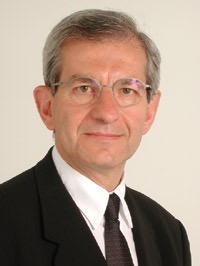
Christian Democracy was a Christian democratic political party in Italy. The DC was founded on 15 December 1943 in the Italian Social Republic as the nominal successor of the Italian People's Party, which had the same symbol, a crusader shield. As a Catholic-inspired, centrist, catch-all party comprising both centre-right and centre-left political factions, the DC played a dominant role in the politics of Italy for fifty years, and had been part of the government from soon after its inception until its final demise on 16 January 1994 amid the Tangentopoli scandals. Christian Democrats led the Italian government continuously from 1946 until 1981. The party was nicknamed the "White Whale" due to its huge organisation and official colour. During its time in government, the Italian Communist Party was the largest opposition party.

Alcide Amedeo Francesco De Gasperi was an Italian politician who founded the Christian Democracy party and served as prime minister of Italy in eight successive coalition governments from 1945 to 1953.

Luigi Longo, also known as Gallo, was an Italian communist politician and general secretary of the Italian Communist Party from 1964 to 1972. He was also the first foreigner to be awarded an Order of Lenin.

The Italian Republican Party is a political party in Italy established in 1895, which makes it the oldest political party still active in the country. The PRI identifies with 19th-century classical radicalism, as well as Mazzinianism, and its modern incarnation is associated with liberalism, social liberalism, and centrism. The PRI has old roots and a long history that began with a left-wing position, being the heir of the Historical Far Left and claiming descent from the political thought of Giuseppe Mazzini and Giuseppe Garibaldi. With the rise of the Italian Communist Party and the Italian Socialist Party (PSI) to its left, it was associated with centre-left politics. The early PRI was also known for its anti-clerical, anti-monarchist, republican, and later anti-fascist stances. While maintaining those traits, during the second half of the 20th century the party moved towards the centre on the left–right political spectrum, becoming increasingly economically liberal.

Pietro Sandro Nenni was an Italian socialist politician, the national secretary of the Italian Socialist Party (PSI) and senator for life since 1970. He was a recipient of the Lenin Peace Prize in 1951. He was one of the founders of the Italian Republic and a central figure of the Italian political left from the 1920s to the 1960s.

Luciano Violante is an Italian judge and politician.

Count Edgardo Pietro Andrea Sogno Rata del Vallino di Ponzone was an Italian diplomat, partisan and political figure. He was born in an aristocratic family from Piedmont.
Piano Solo was an envisaged plot for an Italian anti-communist coup in 1964 requested by then president of the Italian Republic, Antonio Segni. It was prepared by the commander of the Carabinieri, Giovanni de Lorenzo, in the beginning of 1964 in close collaboration with the Italian secret service SIFAR, CIA secret warfare expert Vernon Walters, then chief of the CIA station in Rome William King Harvey, and Renzo Rocca, director of the Gladio units within the military secret service SID. It was named Solo because it was supposed to be directed only by the Carabinieri.

Democratic Union for the New Republic, usually referred to as New Republic was a short-lived political party in Italy founded on 1 March 1964 by Randolfo Pacciardi, a former leading member of the Italian Republican Party (PRI).

Randolfo Pacciardi was an Italian politician.

The Legislature I of Italy was the 1st legislature of the Italian Republic, and lasted from 8 May 1948 until 24 June 1953. Its composition was the one resulting from the general election of 18 April 1948.

The Legislature II of Italy was the 2nd legislature of the Italian Republic, and lasted from 25 June 1953 until 11 June 1958. Its composition was the one resulting from the general election of 7 June 1953.

The Legislature III of Italy was the 3rd legislature of the Italian Republic, and lasted from 12 June 1958 until 15 May 1963. Its composition was the one resulting from the general election of 25 May 1958.

The Legislature X of Italy was the 10th legislature of the Italian Republic, and lasted from 2 July 1987 until 22 April 1992. Its composition was the one resulting from the general election of 14 and 15 June 1987. The election was called by President Cossiga on 28 April 1987, when he dissolved the Houses of Parliament.
The Pentapartito, commonly shortened to CAF, refers to the coalition government of five Italian political parties that formed between June 1981 and April 1991. The pro-European and Atlanticist coalition comprised the Christian Democracy (DC), the Italian Socialist Party (PSI), Italian Democratic Socialist Party (PSDI), Italian Liberal Party (PLI), and Italian Republican Party (PRI).

Ivan Matteo Lombardo was an Italian politician.
The Mazzini Society was an antifascist political association, formed on a democratic and republican basis, situating itself within the tradition of the Risorgimento, and created in the United States by Italian-American immigrants in the late 1930s. It was named after Giuseppe Mazzini, a leading figure of Italian reunification in the mid-19th century, who had worked from exile.
The Centrism was a political formula that inspired the Atlanticist, anti-communist, and centrist governments of the Italian Republic between the end of the 1940s and the early 1950s. The governments of this period, also known as "The Years of Centrism", were characterized by a coalition pact between the Christian Democracy (DC) and the other minor secular parties.

Pietro Bucalossi was an Italian physician and politician. He is remembered for his cancer research, and his austerity and small government policies while Mayor of Milan in the 1960s.

Eugenio Reale was an Italian politician.
















